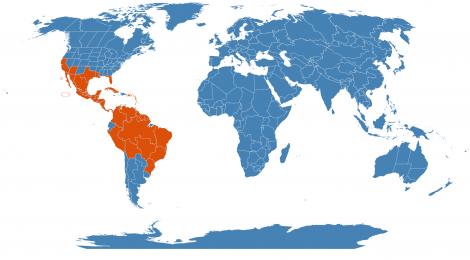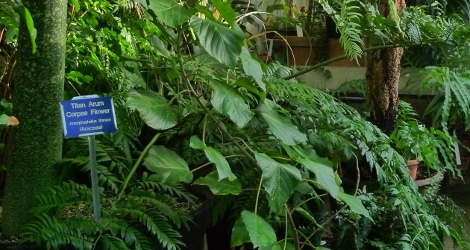Accession Data:
Vachellia farnesiana (Linnaeus) Wight & Arnott
- Common Name: Sweet Acacia, Popinac, Sponge Tree
- Family: Fabaceae Juss.
- Synonym(s): Acacia farnesiana (L.) Willd.
- Country of Origin: widely naturalized, but probably native to S. USA and Mexico

- Habitat: Dry sandy soils in pinelands, hammocks and disturbed areas
- Description: Thorny bush or small tree, 8 m tall; bark light brown, rough; branches glabrous or nearly, purplish to gray, with very small glands; stipules spinescent, usually short, up to 1.8 cm long, rarely longer, never inflated; leaves twice petiole or axis; also applied to how the lateral veins are arranged in relation to the main vein.">pinnate, with a small gland on petiole and sometimes one on the rachis near top of pinnae; pinnae 2–8 pairs, leaflets 10–12 pairs, minute, 2–7 mm long, 0.75–1.75 mm wide, glabrous, leathery; flowers in axillary pedunculate heads, calyx and corolla glabrous, scented; pod indehiscent, straight or curved, 4–7.5 cm long, about 1.5 cm wide, subterete and turgid, dark brown to blackish, glabrous, finely longitudinally striate, pointed at both ends; seeds chestnut-brown, in 2 rows, embedded in a dry spongy tissue, 7–8 mm long, ca 5.5 mm broad, smooth, elliptic, thick, only slightly compressed; areole 6.5–7 mm long, 4 mm wide.
Cassie perfume is distilled from the flowers. Cassie absolute is employed in preparation of violet bouquets, extensively used in European perfumery. Cassie pomades are manufactured In Uttar Pradesh and the Punjab. Pods contain 23 percent tannin, a glucoside of ellagic acid, and are used for tanning leather. Bark also used for tanning and dying leather in combination with iron ores and salts. In Bengal and West Indies, pods are used for a black leather dye. Gummy substance obtained from pods used in Java as cement for broken crockery. Gum exuding from trunk considered superior to gum arabic in arts. Trees used as ingredient in Ivory Coast for arrow poison; elsewhere they are used as fences and to check erosion. Wood is hard and durable underground, used for wooden plows and for pegs. Trees often planted as an ornamental. Morton (1981) says that the seeds, containing an unnamed alkaloid, are used to kill rabid dogs in Brazil.
Probably native to sub-tropical America, but naturalized and cultivated all over the world, e.g. Africa (Rhodesia, Mozambique) and Australia. Planted in coastal areas of Ghana and elsewhere in tropical Africa. Grown throughout India, and often planted in gardens.
Thrives in dry localities and on loamy or sandy soils where it may serve as a sand binder. Will grow on loose sandy soil of river beds, on pure sand in plains of Punjab. Requires a dry tropical climate. Ranging from Warm Temperate Dry through Tropical Desert to Moist Forest Life Zones, cassie is reported to tolerate annual precipitation of 6.4–40.3 dm (mean of 20 cases 14.0 dm), annual mean temperature of 14.7–27.8°C (mean of 20 cases = 24.1°C), and pH of 5.0–8.0 (mean of 15 cases = 6.8).
- Uses: The bark and the fruit are a source of tannin and used in making dyes and inks.
- USDA Zone: 9-11
Accession Data:
- Accession # 198500174
- Source: Unknown
- Accession Date: 12-31-1985
- Bench: 1318 - NEOA: Ground Bed 2 SW
- Currently: active - healthy
- Qty: 2 confirmed on 03-24-2025
Classification:
- Division: Magnoliophyta
- Class: Magnoliopsida
- SubClass: eurosid I
- Order: Fabales
- SubOrder:
- Family: Fabaceae
- SubFamily: Mimosoideae
- Tribe: Acacieae
- SubTribe:
Flowering Data:
This accession has been observed in bloom on:| Year | Jan | Feb | Mar | Apr | May | Jun | Jul | Aug | Sep | Oct | Nov | Dec | ||||||||||||||||||||||||||||||||||||||||
|---|---|---|---|---|---|---|---|---|---|---|---|---|---|---|---|---|---|---|---|---|---|---|---|---|---|---|---|---|---|---|---|---|---|---|---|---|---|---|---|---|---|---|---|---|---|---|---|---|---|---|---|---|
| 2025 | ||||||||||||||||||||||||||||||||||||||||||||||||||||
| 2024 | ||||||||||||||||||||||||||||||||||||||||||||||||||||
| 2023 | ||||||||||||||||||||||||||||||||||||||||||||||||||||
| 2022 | ||||||||||||||||||||||||||||||||||||||||||||||||||||
| 2021 | ||||||||||||||||||||||||||||||||||||||||||||||||||||
| 2020 | ||||||||||||||||||||||||||||||||||||||||||||||||||||
| 2019 | ||||||||||||||||||||||||||||||||||||||||||||||||||||
| 2018 | ||||||||||||||||||||||||||||||||||||||||||||||||||||
| 2017 | ||||||||||||||||||||||||||||||||||||||||||||||||||||
| 2016 | ||||||||||||||||||||||||||||||||||||||||||||||||||||
| 2015 | ||||||||||||||||||||||||||||||||||||||||||||||||||||
| 2014 | ||||||||||||||||||||||||||||||||||||||||||||||||||||
| 2013 | ||||||||||||||||||||||||||||||||||||||||||||||||||||
| 2012 | ||||||||||||||||||||||||||||||||||||||||||||||||||||
| 2011 | ||||||||||||||||||||||||||||||||||||||||||||||||||||
| 2010 | ||||||||||||||||||||||||||||||||||||||||||||||||||||
| 2009 | ||||||||||||||||||||||||||||||||||||||||||||||||||||
| 2008 | ||||||||||||||||||||||||||||||||||||||||||||||||||||
| 2007 | ||||||||||||||||||||||||||||||||||||||||||||||||||||
| 2006 | ||||||||||||||||||||||||||||||||||||||||||||||||||||
References (internal):
- Dye Plants
- Plants with Extrafloral Nectaries
- Type Species
- EEB 3271 - Systematic Botany
- EEB 3203 - Developmental Plant Morphology
- EEB Greenhouse Holdings native to: Arizona / California / Texas / Florida / Louisiana / Mexico Central / Mexico Northeast / Mexico Gulf / Mexican Pacific Is. / Mexico Northwest / Mexico Southwest / Mexico Southeast / Belize / Costa Rica / El Salvador / Guatemala / Honduras / Nicaragua / Panama / Cuba / Leeward Is. / Netherlands Antilles / Puerto Rico / Windward Is. / French Guiana / Guyana / Suriname / Venezuela / Bolivia / Colombia / Peru / Brazil West-Central / Brazil Northeast / Brazil Southeast / Brazil North / Brazil South
References (external):
- Vachellia farnesiana Factsheet - dead link as of last access on Tuesday, February 13, 2018.
- Acacia farnesiana at Plants For A Future. Last accessed on Tuesday, February 13, 2018.
- Acacia farnesiana at Purdue NewCrops Website. Last accessed on Tuesday, February 13, 2018.
- The Plant List (2013). Version 1.1. Last accessed on Tuesday, February 13, 2018.
- Vachellia farnesiana at ARS-GRIN. Last accessed on Tuesday, February 13, 2018.
data regenerated on Thu, 03 Jul 2025 13:57:02 -0400 [bcm v4.0]
Images:

Additional images for this accession:
Click on thumbnails to enlargeCurrent Accessions in the Fabaceae
Subfamily Caesalpinioideae
Subfamily Caesalpinioideae
Tribe Cassieae
- Cassiinae: Cassia fistula

- Cassiinae: Senna corymbosa


- Ceratoniinae: Ceratonia oreothauma W/C

- Ceratoniinae: Ceratonia siliqua


- Ceratoniinae: Ceratonia siliqua


Subfamily Caesalpinioideae
Tribe Detarieae
Subfamily Faboideae
Tribe Amorpheae
Subfamily Faboideae
Tribe Desmodieae
- Desmodiinae: Codariocalyx motorius


Subfamily Faboideae
Tribe Genisteae
Subfamily Faboideae
Tribe Millettieae
Subfamily Faboideae
Tribe Phaseoleae
- Cajaninae: Rhynchosia phaseoloides


- Clitoriinae: Clitoria ternatea

- Erythrininae: Apios americana

- Erythrininae: Erythrina crista-galli

- Erythrininae: Erythrina sandwicensis W/C


Subfamily Faboideae
Tribe Sophoreae
Subfamily Mimosoideae
Tribe Acacieae
- Acacia angustissima


- Acacia arabica
- Acacia brachybotrya

- Acacia longifolia subsp. sophorae

- Acacia saligna


- Vachellia cornigera


- Vachellia farnesiana


- Vachellia hindsii


Subfamily Mimosoideae
Tribe Ingeae
Subfamily Mimosoideae
Tribe Mimoseae
W/C = Wild Collected
 = indicates flowering in past 14 days
= indicates flowering in past 14 days
 = images available for this accession
= images available for this accession
 = map available for this accession
= map available for this accession
 = accession added within past 90 days
= accession added within past 90 days

